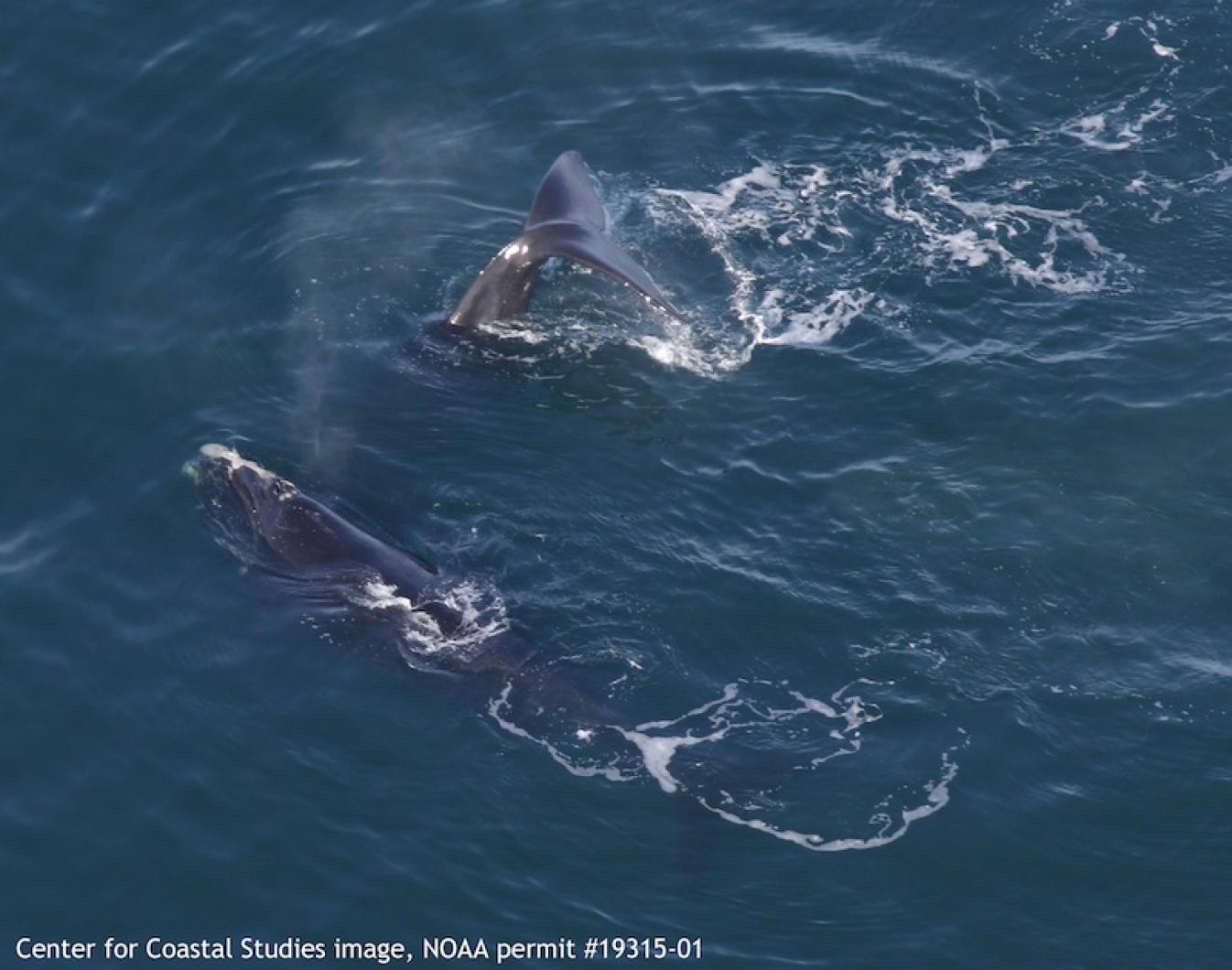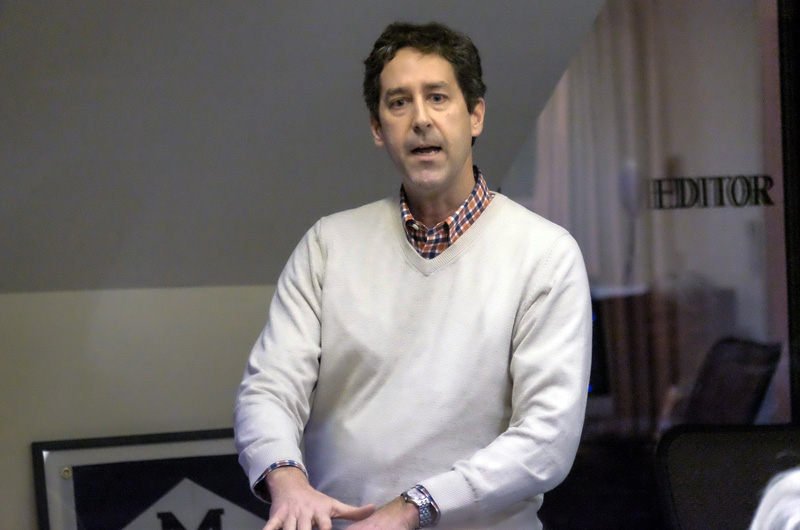About 25 North Atlantic right whales gathered south of the Vineyard this week, marking an early-season sighting of a species that scientists warn could go extinct in the next 20 years.
The sighting belies the plight of the species, Dr. Mark Baumgartner told a crowd of about 50 people gathered in the Gazette newsroom Tuesday for a talk. There are an estimated 450 whales left.
Mr. Baumgartner, a scientist with Woods Hole Oceanographic Institution and president of the North Atlantic Right Whale Consortium, said he and other scientists have documented an alarming decline in right whale calving rates alongside a rise in deaths from fishing gear entanglement.
“We have years, not decades to fix this problem. The longer we wait, the harder the problem gets to fix.” Mr. Baumgartner said. “We don’t need more science to be done on this species. We need to act.”
While the situation is grave, he said, solutions including weaker fishing rope and an emerging ropeless fishing technology that could reduce the number of entanglements that kill or injure the whales.
North Atlantic right whales are about the size of a city bus, and individuals can be identified by unique patterns of callosities on their heads. The whales eat copepods, tiny crustaceans, to the tune of one or two tons a day, Mr. Baumgartner said, the caloric equivalent of about 3,000 Big Macs.
Right whales got their name because they were the “right” whales to pursue during the whaling era. The whales are slow-moving, live near shore, and float after they are killed, making them easier to drag ashore.
The population was decimated beginning around the time of the Revolutionary War. “They’ve been down for along time, but not out,” Mr. Baumgartner said.
More recently, scientists have closely monitored the population from the southern Atlantic calving grounds they visit in the winter to feeding grounds off New England and Canada. Two recent trends paint a dire picture, Mr. Baumgartner said. Last winter, five right whale calves were born, the smallest number scientists have documented in 17 years. So far, he said, no calves have been seen this year. “This year I fear may be worse,” he said.
Scientists have also documented increasing amounts of time between when females give birth to calves, and a decline in first-time mothers. Meanwhile, 17 right whales were found dead last year, 12 in Canada and five in the United States. Three of the whales found in the U.S. were on or near Martha’s Vineyard.
The two main causes of unnatural whale deaths are fishing gear entanglements and ship strikes. Deaths from ship strikes have declined significantly in recent years, Mr. Baumgartner said, after rules were enacted requiring ships within 20 miles of East Coast ports to reduce their speed at critical times. After the right whales were seen south of the Vineyard and Nantucket this week, the government issued a voluntarily vessel speed restriction, asking ships to reduce speed in those areas until Feb. 5.
At the same time, fishing gear entanglements have been on the rise. Rope attached to lobster pots is the culprit in entanglements, Mr. Baumgartner said. In recent decades fishermen have been using stronger rope, making it harder for whales to break free.
“It’s important to understand that entanglements are gruesome events for those animals,” Mr. Baumgartner said. One whale that was entangled in a snow crab pot in Canada dragged the gear all the way to Florida, he said. It is clear many whales suffer for some time before they die, he also said.
“I think if this was happening to a land mammal, in full view of the public . . . it wouldn’t be happening,” Mr. Baumgartner said. “Most people don’t know this is how right whales die.”
Entanglements that aren’t fatal hurt the population in other ways. Whales expend more calories and lose weight, which in turn affects reproductive rates.
The situation is clear, the WHOI scientist said. “I don’t want to research this thing to death,” he said. “We need to be doing something.”
Potential solutions range from taking steps to address fishing gear entanglement to the complete closure of the lobster fishery. The latter is not a desirable outcome, Mr. Baumgartner said. “I don’t think any sane person would really want to propose that,” he said. “Lobster fishing is as iconic in New England as right whales are.”
Ground lines are already required to be sunk in Massachusetts, Mr. Baumgartner said. “Massachusetts fishermen have done more for whale conservation than any other state,” he said, also pointing to fishing closures in Cape Cod Bay during the right whale season. These actions could be introduced in other states, like Maine, he suggested.

Mandating weaker rope, along the lines of 1,700-pound breaking strength, would be one of the quickest remedies, he said. It would not prevent entanglements, but would make it easier for the whales to break free.
The most comprehensive measure includes using ropeless technology for fishing gear, which would see fishermen using acoustic devices to raise gear from the ocean floor. Scientists have the technology ready to go, Mr. Baumgartner said. Introducing the gear would require cooperation with the fishing industry and an experimental fishery to test the equipment.
Ropeless technology would also affect other animals at risk of entanglement, including other whales, sharks and leatherback turtles.
“It’s a completely solvable problem,” Mr. Baumgartner said.
Last week three environmental and animal rights organizations filed a complaint against the federal government, claiming that the Department of Commerce and National Marine Fisheries Service failed to protect right whales by continuing to authorize the American lobster fishery despite the impact on whales.
The Center for Biological Diversity, Defenders of Wildlife and the Humane Society of the United States asks the court to require the government to put in place mitigation measures to protect whales.
Mr. Baumgartner said the lawsuit is part of a natural process of holding the government accountable. He said agencies have been slow to respond to concerns about whether whale protection regulations are being followed or are working. “So the nongovernmental organizations come in to sue the government, to come in and say speed it up,” he said.
As scientists continue to monitor the species and others press the government for action, Mr. Baumgartner disagreed with the suggestion that people stop eating lobster as a meaningful action. “Lobster fishing and whales can be completely compatible,” he said, instead encouraging people to ask fish markets where their lobsters came from and how they had been caught.
Talking to suppliers can change an entire industry he said, pointing to the movements in support of cage-free eggs and free-range chickens.
“Keep asking the government what we are doing about this,” he said. “This past year has changed the conversation completely about right whales.”









Comments (25)
Comments
Comment policy »